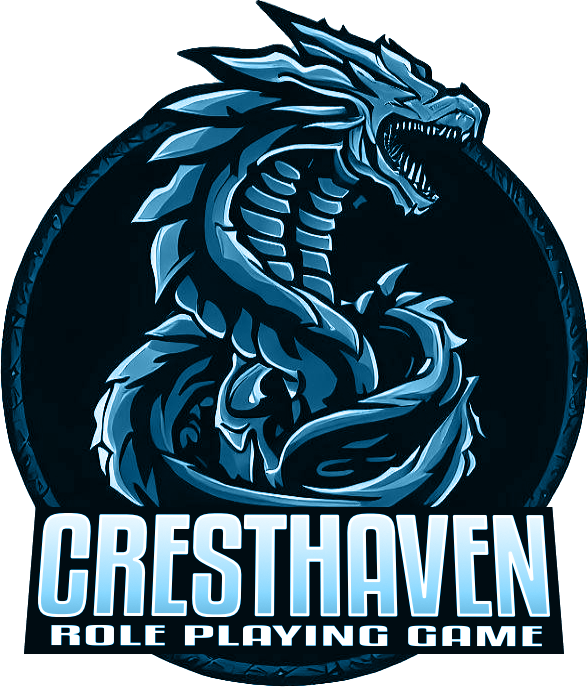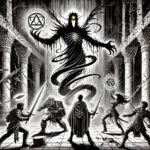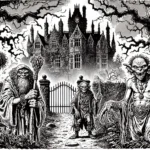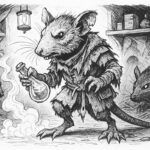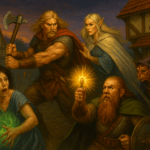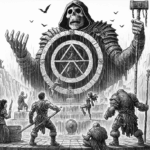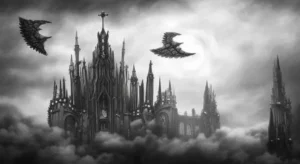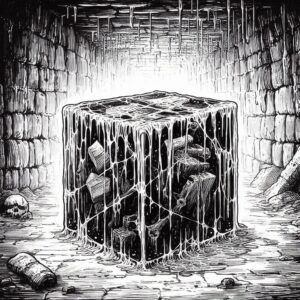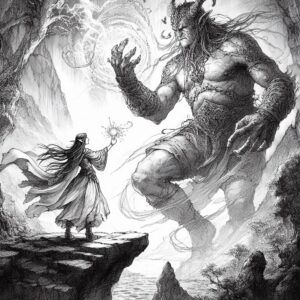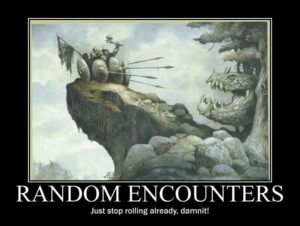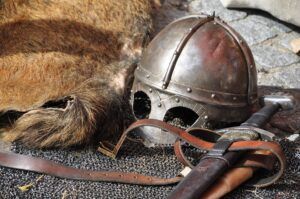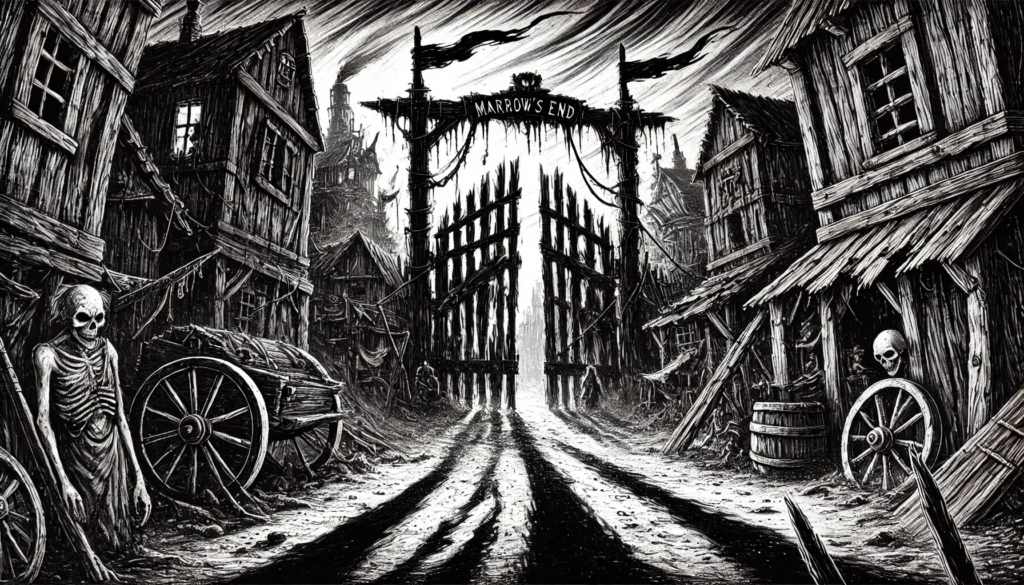
Shadows of Marrowgrave
An Adventure for 4-6 Characters of 4th-6th Level
Adventure Overview
In the abandoned mining town of Marrow’s End, an ancient evil has stirred. Intelligent ghouls have emerged from the depths below, terrorizing the few remaining residents before vanishing back into the labyrinthine tunnels beneath the earth. This is not a simple monster hunt—it’s a deadly game of cat and mouse where the players must become both hunters and hunted.
Unlike traditional dungeon crawls with fixed locations, Shadows of Marrowgrave is a dynamic pursuit adventure where the environment itself becomes a weapon in the hands of cunning predators. The ghouls use psychological warfare, environmental manipulation, and guerrilla tactics to turn the underground maze into their hunting ground.
Adventure Themes:
- Psychological horror and mounting tension
- Environmental challenges and dynamic terrain
- Tactical combat with intelligent enemies
- Resource management under pressure
Opening Hook
When you’re ready to begin the adventure, read the following aloud:
As you approach the forsaken gates of Marrow’s End, the cold wind whistles through empty buildings like the voices of the departed. This mining town, once vibrant with the sounds of industry and life, now sits in eerie silence. Abandoned carts sit where they were left, tools scattered as if their owners simply vanished mid-work.
You’re here because something terrible has emerged from the earth below. Ghouls—nightmarish creatures of legend—have been crawling up from the ancient tunnels, terrorizing and abducting the few remaining residents before disappearing back into the depths. Your mission is clear: track down these elusive predators and destroy them before their numbers grow and threaten the surrounding settlements.
As you enter the town square, the wind carries an unsettling sound—a faint scratching, like claws on stone, echoing from somewhere beneath your feet. The collapsed entrance to the old mine yawns before you like a wound in the earth, and you realize that beneath this quiet town lies a network of twisted tunnels teeming with cunning, hungry horrors eager to turn your pursuit into their hunt.
GM Notes: Allow the characters time to explore the surface and prepare. This is their last chance to strategize in relative safety before entering the psychological pressure cooker below.
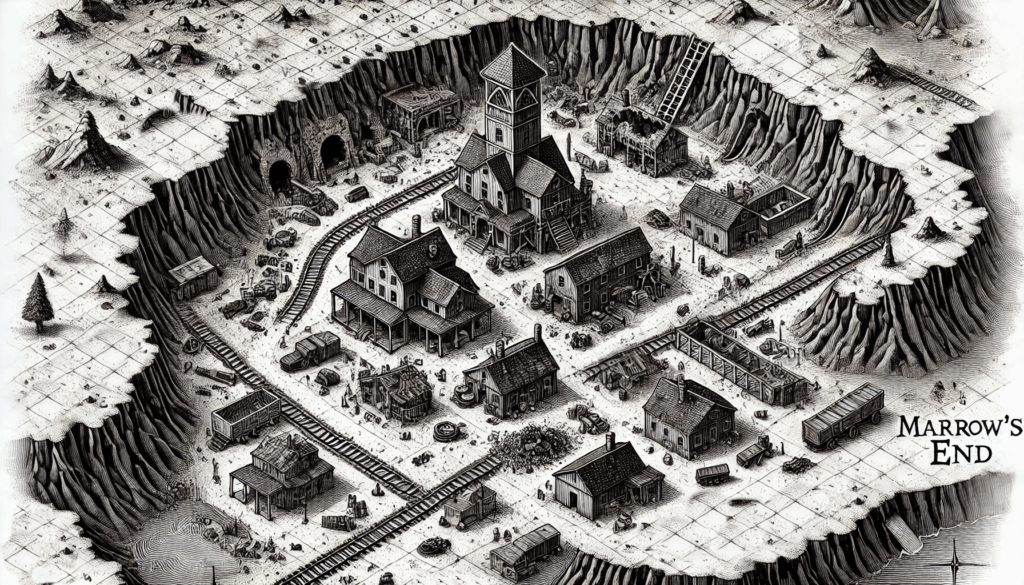
The Surface: Marrow’s End
Town Square and Surroundings
The abandoned mining town serves as both staging area and potential refuge. Key locations include:
The Town Square: A central area with crumbling buildings that can provide shelter and vantage points. Characters might find abandoned supplies or clues about the ghouls’ emergence.
Collapsed Mine Entrance: The most obvious entry point to the tunnels below. The collapse appears recent, with claw marks visible on the exposed timbers—clear signs of the ghouls’ passage.
The Overgrown Graveyard: Located on the town’s outskirts, this cemetery contains hidden entrances to the crypt system below. Characters who search carefully might discover alternative routes into the underground network.
Abandoned Buildings: Former homes and shops that may contain useful supplies, information from hastily written notes, or evidence of the ghouls’ surface raids.
Investigation Opportunities
Characters can spend time on the surface gathering information:
- Examining the Mine Entrance: Reveals the collapse was caused from below, not above
- Searching Buildings: May uncover survivor accounts, crude maps of tunnel entrances, or abandoned equipment
- Investigating the Graveyard: Can reveal that several graves have been disturbed from beneath
- Tracking Signs: Shows ghoul movement patterns between various tunnel entrances
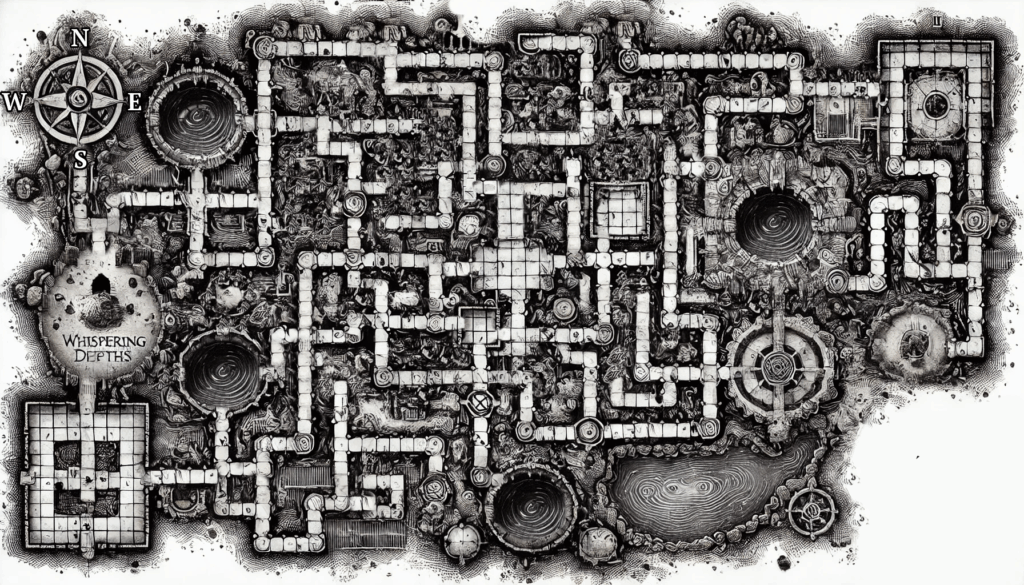
The Whispering Depths: Environment and Atmosphere
The underground network beneath Marrow’s End is not a traditional dungeon with fixed rooms and corridors. Instead, it’s a dynamic, ever-changing maze that the ghouls manipulate to their advantage.
Core Environmental Features
Maze-like Tunnels: The passages form a complex network with multiple levels, false dead ends, and hidden connections. No map can fully capture the layout because the ghouls constantly modify it through collapses and excavation.
Unstable Architecture: Centuries of mining have left the tunnels structurally compromised. The ghouls exploit this, using collapses tactically to separate parties or block retreat routes.
Natural Ambush Points: Hidden alcoves, false floors, and concealed openings provide countless opportunities for surprise attacks. The ghouls know every hiding spot and secret passage.
Variable Water Levels: Some passages flood unpredictably due to underground springs or ghoul manipulation of drainage systems. Rising water can force rapid decisions and dangerous shortcuts.
Oppressive Darkness: The tunnels exist in perpetual darkness broken only by what light the characters bring. The ghouls use this to their advantage, attacking from beyond the light’s reach.
Dynamic Environment Rules
The underground environment actively works against the characters through several mechanisms:
Structural Instability: Loud noises, combat, or simply the passage of time can trigger collapses. These serve multiple purposes:
- Separating party members
- Blocking retreat routes
- Creating new pathways
- Generating noise that masks ghoul movement
Flooding Hazards: Water levels can rise suddenly due to:
- Natural underground springs
- Ghoul manipulation of drainage
- Structural damage affecting water flow
- Tidal effects from distant water sources
Disorientation Effects: The maze-like nature of the tunnels creates natural confusion:
- Multiple similar-looking passages
- False tunnels that lead nowhere
- Circular routes that bring characters back to familiar areas
- Acoustic effects that distort sound direction
The Ghouls: Masters of Psychological Warfare
Gharruk the Stalker
The pack leader is an ancient ghoul whose intelligence and cunning far exceed that of typical undead. Gharruk has spent decades learning every inch of the tunnel network and views the underground as his personal hunting preserve.
Personality: Intelligent, patient, and sadistically playful. Gharruk enjoys the psychological aspect of the hunt as much as the kill. He speaks in whispers that echo through the tunnels, taunting the characters and undermining their confidence.
Tactics: Gharruk never engages in direct combat unless absolutely necessary. Instead, he orchestrates elaborate ambushes, coordinates his pack’s movements, and manipulates the environment to maximum effect.
Pack Behavior and Tactics
The ghouls operate as a coordinated unit with sophisticated tactics:
Ambush Specialists: They strike suddenly from concealed positions, inflict damage quickly, then retreat through hidden passages before the characters can mount an effective response.
Psychological Warfare: The ghouls use sound, movement, and brief appearances to create constant tension:
- Scratching claws on stone walls just beyond sight
- Whispered threats in languages both familiar and unknown
- Brief glimpses of movement in peripheral vision
- Eerie laughter echoing from multiple directions
Environmental Manipulation: The ghouls actively modify their environment:
- Triggering collapses to split the party
- Flooding passages to force movement
- Creating false trails and dead ends
- Blocking escape routes during attacks
Adaptive Intelligence: The pack learns from each encounter:
- If characters use aggressive tactics, ghouls lure them into dangerous terrain
- If characters proceed cautiously, ghouls increase pressure through harassment
- If characters use light extensively, ghouls attack from maximum range
- If characters stay grouped, ghouls attempt to separate them
Running the Adventure: GM Guidelines
Building Atmospheric Tension
The key to this adventure is maintaining constant psychological pressure. Use these techniques throughout:
Sensory Details: Describe subtle signs of ghoul presence:
- “You hear the faint sound of claws scraping against stone, always just around the next corner”
- “A low murmur echoes through the tunnels—almost like conversation, but in no language you recognize”
- “Something moves in your peripheral vision, but when you turn, there’s nothing there”
Escalating Encounters: Each ghoul encounter should increase in intensity:
- Initial Contact: Brief glimpses and distant sounds
- Probing Attacks: Quick strikes followed by immediate retreat
- Coordinated Harassment: Multiple simultaneous threats from different directions
- Environmental Assault: Major collapses or flooding combined with attacks
- Final Confrontation: Direct assault in Gharruk’s prepared killzone
Uncertainty and Paranoia: Keep players guessing:
- Describe movement from multiple directions simultaneously
- Use echoes and acoustics to confuse sound sources
- Occasionally have “attacks” turn out to be environmental effects
- Let characters glimpse the same ghoul in impossible locations
Dynamic Encounter Framework
Rather than fixed encounters, use this flexible system:
Encounter Triggers: Initiate ghoul activity based on:
- Character actions (loud noises, aggressive pursuit, splitting up)
- Time pressure (the longer characters spend underground, the bolder ghouls become)
- Environmental factors (entering unstable areas, reaching flooded sections)
- Narrative pacing (when tension needs to increase or decrease)
Escalation Ladder: Each encounter should build on previous ones:
- Observation: Ghouls watch and learn character tactics
- Testing: Quick probing attacks to assess defenses
- Harassment: Sustained pressure to force mistakes
- Exploitation: Full attacks when characters are separated or vulnerable
- Desperation: All-out assault when cornered or protecting their lair
Environmental Challenge Examples
Cave-In Encounters:
- Trigger: Loud combat, structural weakness, or ghoul sabotage
- Immediate Effect: Blocks passage, separates party, creates new routes
- Tactical Use: Ghouls attack isolated characters or use noise to mask approach
- Resolution: Characters must find alternate routes or clear rubble
Flooding Scenarios:
- Trigger: Ghoul manipulation, structural damage, or natural causes
- Immediate Effect: Rising water forces rapid movement decisions
- Tactical Use: Ghouls attack while characters are vulnerable or distracted
- Resolution: Find higher ground, drainage, or brave the flood
False Tunnel Traps:
- Trigger: Characters follow obvious or marked paths
- Immediate Effect: Dead ends, loops, or collapse traps
- Tactical Use: Waste time, separate party, create ambush opportunities
- Resolution: Careful mapping, backtracking, or finding hidden passages
Specific Encounter Scenarios
The Opening Gambit
Setup: Shortly after entering the tunnels, characters hear movement ahead and behind them.
Execution:
- Describe scratching sounds from multiple directions
- Show brief glimpses of movement in torchlight
- Have ghouls retreat when characters advance
- End with eerie laughter echoing from the darkness
Purpose: Establish that the characters are being watched and that the ghouls control this environment.
The Separation
Setup: Characters must navigate a partially collapsed section with multiple narrow passages.
Execution:
- Structural weakness forces single-file movement
- Ghouls trigger collapse to separate strongest/weakest members
- Isolated characters face probing attacks
- Reunification requires navigating alternate routes under pressure
Purpose: Test party cohesion and individual character capabilities.
The False Retreat
Setup: Characters encounter ghouls in apparent retreat toward what seems like their lair.
Execution:
- Ghouls allow themselves to be “discovered” and flee dramatically
- Characters who pursue find themselves in a prepared killzone
- Multiple ambush points, environmental hazards, and escape routes favor the ghouls
- Successful characters realize the trap and adapt accordingly
Purpose: Punish overly aggressive tactics while rewarding tactical thinking.
The Flooding Gambit
Setup: Characters enter a lower section where ghouls can control water flow.
Execution:
- Water begins rising, forcing movement through specific passages
- Ghouls attack while characters deal with environmental hazard
- Characters must choose between safety and pursuit
- Resolution requires dealing with both threats simultaneously
Purpose: Test resource management and decision-making under pressure.
Gharruk’s Den: The Final Confrontation
Lair Characteristics
Gharruk’s den sits at the deepest accessible level of the tunnel network. Unlike the maze above, this area is carefully prepared for a final stand:
Bone-Strewn Chamber: The main lair contains the remains of previous victims, both as trophies and psychological weapons. The bones create difficult terrain and hiding spots.
Multiple Escape Routes: Hidden passages allow rapid retreat if the encounter goes poorly for the ghouls. Characters must anticipate and block these to prevent Gharruk’s escape.
Environmental Advantages: The chamber includes:
- Unstable ceiling that can be collapsed strategically
- Water channels that can be flooded or drained
- Hidden alcoves for ambush attacks
- Narrow passages that limit character movement
Final Encounter Tactics
Initial Setup: Gharruk attempts to draw characters into the chamber on his terms, possibly using captives, treasure, or feigned weakness as bait.
Combat Progression:
- Opening: Gharruk taunts characters while pack members attack from concealment
- Escalation: Environmental hazards activate (collapses, flooding, gas pockets)
- Desperation: Direct assault when other tactics fail
- Retreat: Attempt to escape through hidden passages if severely threatened
Victory Conditions: Characters must either:
- Defeat Gharruk and his remaining pack
- Force them to retreat permanently from the area
- Collapse critical sections to trap them deeper underground
Outcomes and Consequences
Complete Success
- Gharruk defeated and pack scattered or destroyed
- Tunnel network secured or collapsed to prevent future threats
- Marrow’s End safe for resettlement
- Characters gain reputation as skilled monster hunters
Partial Success
- Ghouls driven deeper underground but not eliminated
- Temporary respite for the region
- Ongoing threat requires future intervention
- Characters learn valuable lessons about fighting intelligent undead
Failure
- Ghoul pack remains active and possibly grows stronger
- Threat spreads to neighboring settlements
- Characters may become targets for future ghoul attacks
- Adventure seeds for return expeditions or rescue missions
Character Rewards
Experience Points
- Defeating Gharruk: 500 XP per character
- Securing tunnels and town: 200 XP per character
- Creative problem-solving and teamwork: 100 XP per character
- Environmental challenge survival: 50 XP per significant hazard overcome
Treasure Opportunities
Ancient Relics: Predating the mining town, these items might have historical significance or minor magical properties.
Valuable Minerals: Forgotten mining caches containing precious metals, gems, or rare materials useful for crafting.
Previous Adventurers’ Equipment: Gear from less successful expeditions, possibly damaged but repairable, or containing clues about other threats.
Ghoul Trophies: Proof of victory that can be traded for rewards or reputation in nearby settlements.
Long-term Benefits
Reputation: Characters become known as specialists in fighting intelligent undead, leading to similar contracts.
Knowledge: Understanding ghoul tactics and underground environments proves valuable in future adventures.
Contacts: Grateful survivors or regional authorities may provide information, resources, or future opportunities.
Campaign Integration
Immediate Hooks
The Curse’s Source: Investigation might reveal that the ghouls’ emergence was triggered by:
- Ancient burial sites being disturbed
- Forgotten rituals or curses
- Connection to dark deities or eldritch forces
- Previous expeditions that awakened something better left sleeping
Surviving Threats: Even after defeating Gharruk, characters might face:
- Surviving pack members seeking revenge
- Other undead threats awakened by the disturbance
- Copycat ghoul packs inspired by Gharruk’s tactics
- The original source of the ghoul outbreak
Expanded Campaign Elements
The Architect Connection: Link this adventure to “The Infernal Gauntlet” by having the Architect of Despair take interest in characters who survive both psychological and physical underground challenges.
Regional Threats: Use Marrow’s End as the starting point for a larger campaign involving:
- Network of abandoned settlements with similar problems
- Ancient underground civilizations
- Cult activity related to death and undeath
- Political intrigue around resettlement rights
Character Development: This adventure teaches valuable lessons about:
- Fighting intelligent enemies who adapt to party tactics
- Environmental awareness and hazard management
- Psychological resilience under pressure
- The importance of preparation and resource management
Appendix: Additional Resources
Environmental Hazard Quick Reference
Cave-in: Dexterity Save (DC 15) or take 2d6 bludgeoning damage and become trapped Flooding: Constitution Save (DC 12) each round in rising water or begin drowning Unstable Floor: Wisdom check (DC 13) to notice before stepping; Dexterity Save (DC 14) to avoid falling Poisonous Gas: Constitution Save (DC 14) or suffer disadvantage on all rolls for 1 hour Darkness: Heavily obscured beyond light sources; disadvantage on Wisdom checks relying on sight
Ghoul Behavior Patterns
Confident: When pack is at full strength, ghouls are bold and aggressive Cautious: After taking casualties, ghouls become more selective about engagements Desperate: When cornered or protecting the lair, ghouls fight with reckless abandon Adaptive: Ghouls change tactics based on character behavior and previous encounters
Scaling for Different Party Sizes
Small Parties (3-4 characters): Reduce environmental hazards frequency, have ghouls make more tactical errors Large Parties (6+ characters): Increase environmental complexity, add more simultaneous threats Inexperienced Players: Provide more obvious environmental clues, have Gharruk be more talkative with hints Veteran Players: Reduce warning signs, increase environmental lethality, make ghoul tactics more sophisticated
This adventure framework provides a flexible, engaging experience that adapts to your players’ choices while maintaining the core themes of psychological horror and tactical challenge. The dynamic environment ensures that no two playthroughs will be exactly the same, as the ghouls’ adaptive intelligence creates unique scenarios based on how the characters approach each challenge.
END
Read to Player (Hook): As you approach the forsaken gates of Marrow’s End, the cold wind whispers through empty buildings like ghostly voices. This mining town, once vibrant, is now eerily silent. You’re here because ghouls, nightmarish creatures of legend, have crawled from the earth, terrorizing and abducting residents. Your goal is clear: track down these elusive predators and destroy them before their numbers grow. Beware, for beneath your feet lie twisted tunnels teeming with cunning, hungry horrors eager to turn your pursuit into their hunt.
Setting:
Marrow’s End is an abandoned mining town, beneath which lies the Whispering Depths, a complex network of tunnels and crypts. The passages are ancient, unstable, and riddled with hidden alcoves, false passages, and deceptive shadows, creating a dynamic environment filled with unexpected hazards.
The surface includes the town square, with crumbling buildings and a collapsed mine entrance leading underground. Nearby, an overgrown graveyard holds hidden entrances to the crypt below.
Beneath the surface, the Whispering Depths consist of a maze of narrow tunnels, crypt chambers, waterlogged passages, and hidden alcoves ideal for ambush. At the deepest level lies Gharruk’s Den, a bone-strewn lair surrounded by a labyrinthine network of escape tunnels and hidden exits.
Player Configuration:
Ideal for 4-6 players, levels 4-6.
Main Challenge:
The central threat is a pack of intelligent, cunning ghouls adept in ambush tactics. Players must navigate their labyrinthine lair, survive their calculated strikes, and confront their leader, Gharruk the Stalker, in a dangerous final encounter.
NPC Characters:
Gharruk the Stalker leads the ghouls. Intelligent and ruthless, he excels in stealth and psychological warfare, orchestrating ambushes and retreats to maximize fear and confusion.
Tactics:
The ghouls operate intelligently, rarely fighting openly. They prefer sudden ambushes from multiple directions, using hidden alcoves, tunnels, and passages. They use psychological tactics—whispers, eerie laughter, and unsettling glimpses—to unnerve players. Ghouls manipulate the environment—triggering collapses or flooding tunnels to isolate and disorient their prey.
Possible Player Actions:
Players might carefully track ghoul movements, strategically use spells to reveal threats, rely on teamwork for defense, or search tunnels for vital clues about the ghouls’ weaknesses or motives.
Potential Outcomes:
Complete success sees Gharruk defeated, destroying or scattering the ghoul pack, and securing Marrow’s End. Partial success drives ghouls deeper underground, granting temporary respite. Failure allows the ghoul threat to grow stronger, threatening nearby settlements.
Further Ideas:
Players could uncover an ancient curse or ritual behind the ghouls’ emergence, encounter recurring adversaries in surviving ghouls, or discover links to forgotten Cresthaven gods or eldritch forces.
Treasure:
Rewards include ancient relics, valuable minerals left in the tunnels, and unique equipment or artifacts belonging to adventurers who previously failed.
Experience Points (XP):
Defeating Gharruk: 500 XP per player. Securing tunnels and town: 200 XP per player. Creative problem-solving and teamwork: 100 XP per player.
How to Play the Ghouls (DM Guidance):
The ghouls are masters of cat-and-mouse tactics, engaging adventurers in a deadly psychological and physical chase. Use subtle sensory details to build dread: the distant sound of claws scraping against stone walls, low murmurs echoing unintelligible threats, or brief glimpses of shadowy figures darting across corridors.
When attacking, have ghouls strike suddenly from concealed alcoves or beneath false floors, quickly slashing at players and retreating through secret passages before retaliation. After each strike, emphasize sounds fading into the distance, reinforcing uncertainty and paranoia.
Examples of specific tactics include splitting the party by triggering collapses behind or ahead of them, forcing difficult choices as water begins flooding a tunnel behind them. Occasionally, simulate multiple threats by describing movement from different directions simultaneously, confusing the party and making coordinated defense challenging.
Ghouls adapt intelligently: if players aggressively pursue, lure them into dangerous terrain—such as unstable passages prone to collapse or chambers quickly filling with water. If the players hesitate, ghouls press their advantage by suddenly appearing to harass and unnerve them, forcing hasty decisions.
Maintain psychological pressure by intermittently allowing the players to overhear Gharruk’s mocking voice, taunting them from the darkness, emphasizing their vulnerability. This psychological manipulation is key—players should always feel uncertain, wary, and hunted throughout their exploration of the Whispering Depths.
Environmental Challenges:
- Cave-ins: Sudden tunnel collapses that separate or trap the party.
- Flooded Passages: Rising water levels forcing rapid decision-making and navigation.
- Unstable Floors: Sections of the ground that crumble away unexpectedly underfoot.
- False Tunnels: Passages deliberately created to mislead and trap explorers.
- Narrow Passageways: Restrictive tunnels limiting movement, hindering combat and escape.
- Darkness: Perpetual, oppressive darkness that complicates exploration and combat.
- Poisonous Gas Pockets: Natural gas leaks that cause disorientation or injury.
- Echoing Chambers: Natural acoustics that amplify sounds, creating confusion and panic.
Discover more from Cresthaven RPG
Subscribe to get the latest posts sent to your email.
